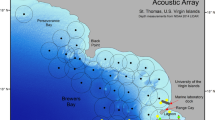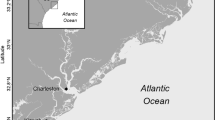Abstract
Early life stage tarpon (Megalops atlanticus) have been collected in the western Atlantic Ocean north of Florida where it has been assumed that individuals migrate from estuarine areas at the onset of winter because water temperature during winter is too low for survival. However, there is anecdotal evidence of juvenile tarpon present during winter in this region. We conducted a tag-recapture study to examine potential overwinter survival in a tidally-restricted, upland pond in coastal South Carolina where tarpon have been observed during winter months. We also estimated the age structure of tarpon in this location to determine if age-0 fish were temporarily using this pond or if there were older individuals present, indicating the pond may be occupied for extended periods of time. We recaptured 29 of the 95 individuals tagged and released during January 2016 through October 2018. Of those 29 recaptured individuals, 13 survived one winter and two survived over two winters. Water temperature during winter in a nearby tidal creek was lower than in the pond, which appeared to provide a thermal refuge for tarpon. Estimated ages for 36 individuals ranged from 0 to 3 years (n = 10, 20, 5, 1, respectively). To our knowledge this is the northernmost documented overwintering of juvenile tarpon. Determining the extent of this type of habitat in the region and examining the population dynamics of tarpon in these locations could ultimately help determine how this region contributes to the productivity of adult tarpon populations.





Similar content being viewed by others
References
Allen DM, Allen WB, Feller RF, Plunket JS (2014) Site profile of the North Inlet-Winyah Bay National Estuarine Research Reserve. North Inlet-Winyah Bay National Estuarine Research Reserve, Georgetown pp 432
Baker TL, Jennings CA (2005) Striped bass survival in Lake Blackshear, Georgia during drought conditions: implications for restoration efforts in Gulf of Mexico drainages. Environ Biol Fish 72:73–84
Breder CM Jr (1944) Materials for the study of the life history of Tarpon atlanticus. Zoologica 29:217–252
Crabtree RE, Cyr EC, Dean JM (1995) Age and growth of tarpon, Megalops atlanticus, from South Florida waters. Fish Bull 93:619–628
Cyr EC (1991) Aspects of the life history of the tarpon, Megalops atlanticus, from South Florida. PhD Dissertation, University of South Carolina, Columbia, SC, 138 pp
Diana JS (2004) Biology and ecology of fishes, 2nd edn. Biological Sciences Press, Carmel
Harrington RW Jr (1958) Morphometry and ecology of small tarpon, Megalops atlantica Valenciennes from transitional stage through onset of scale formation. Copeia 1958:1–10
Harrington RW Jr (1966) Changes through one year in the growth rates of tarpon, Megalops atlanticus Valenciennes, reared from mid-metamorphosis. Bull Mar Sci 16:863–883
Hettler WF Jr, Chester AJ (1990) Temporal distribution of ichthyoplankton near Beaufort inlet, North Carolina. Mar Ecol Prog Ser 68:157–168
Hildebrand SF (1934) The capture of a young tarpon, Tarpon atlanticus, at Beaufort, North Carolina. Copeia 1934:45–46
Mace MM III, Haffey ER, Kimball ME (2017) Low-temperature tolerance of juvenile tarpon Megalops atlanticus. Environ Biol Fish 100:913–922
Mace MM III, Kimball ME, Haffey ER (2018) Recruitment and habitat use of early life stage tarpon (Megalops atlanticus) in South Carolina estuaries. Estuar Coasts 41:841–854
McGovern JC, Wenner CA (1990) Seasonal recruitment of larval and juvenile fishes into impounded and non-impounded marshes. Wetlands 10:203–221
McInerny MC (2017) Scales. In: Quist MC, Isermann DA (eds) Age and growth of fishes: principles and techniques. American Fisheries Society, Bethesda, pp 127–158
Moffett AW, Randall JE (1957) The Roger Firestone tarpon investigation progress report. University of Miami, FL. pp 18
Morson JM, Grothues T, Able KW (2019) Change in larval fish assemblage in a USA east coast estuary estimated from twenty-six years of fixed weekly sampling. PLoS One 14:e0224157
Moss JL (1985) Summer selection of thermal refuges by striped bass in Alabama reservoirs and tailwaters. Trans Am Fish Soc 114:77–83
Nichols KM (1994) Age and growth of juvenile tarpon, Megalops atlanticus from Costa Rica, South Carolina, and Venezuela. Honor’s Thesis, University of South Carolina, Columbia, SC, pp 52
Ogle DH (2016) FSA: fisheries stock analysis. R package version 0.8.7
Power G, Brown RS, Imhof JG (1999) Groundwater and fish - insights from northern North America. Hydrol Process 13:401–422
Quist MC, Pegg MA, DeVries DR (2013) Age and growth. In: Zale AV, Parrish DL, Sutton TM (eds) Fisheries techniques. American Fisheries Society, Bethesda
Rickards WL (1966) A study of the ecology of first-year tarpon, Megalops atlantica Valenciennes, in a Georgia salt-marsh, with laboratory studies of growth rates and ecological growth efficiencies. Master’s Thesis, University of Georgia, Athens, GA, pp 67
Rickards WL (1968) Ecology and growth of juvenile tarpon, Megalops atlanticus, in a Georgia salt marsh. Bull Mar Sci 18:220–239
Robinson KF, Jennings CA (2014) Productivity of functional guilds of fishes in managed wetlands in coastal South Carolina. Journal of Fish and Wildlife Management 5:70–86
Schwartz FJ (2002) Occurences of elopiform fishes of the genera Elops, Megalops, and Albula in North Carolina. J N C Acad Sci 118:86–90
Schwartz FJ, Safrit G, Purifoy J, Butterfield R (1993) A 10-month survey of fishes and invertebrates inhabiting a 30-yr old barrier island dredged canal system at Pine Knoll Shores, North Carolina. The Journal of the Elisha Mitchell Scientific Society 109:99–114
Stein W, Shenker J, O’Connell MT (2016) A contribution to the life history of tarpon (Megalops atlanticus) in the northern Gulf of Mexico. Southeast Nat 15:496–512
Storey M, Perry LM (1933) A record of young tarpon at Sanibel Island, Lee County, Florida. Science 78:284–285
Tucker JW, Hodson RG (1976) Early and mid-metamorphic larvae of the tarpon, Megalops atlantica, from the Cape Fear River estuary, North Carolina, 1973–74. Chesap Sci 17:123–125
Twomey E, Byrne P (1985) A new record for the tarpon, Tarpon atlanticus Valenciennes (Osteichthyes-Elopiformes-Elopidae), in the eastern North Atlantic. J Fish Biol 26:359–362
Wade RA (1962) The biology of the tarpon, Megalops atlanticus, and the ox-eye, Megalops cyprinoides, with emphasis on larval development. Bull Mar Sci Gulf Caribb 12:545–622
Wilson JK, Adams AJ, Ahrens RNM (2019) Atlantic tarpon (Megalops atlanticus) nursery habitats: evaluation of habitat quality and broad-scale habitat identification. Environ Biol Fish 102:383–402
Wright KK, Schrader W, Reinhardt L, Hernanadez K, Hohman C, Copeland T (2015) Process and methods for assigning ages to anadromous salmonids from scale samples. Idaho Department of Fish and Game, Report Number 15-03. 48 pp.
Zerbi A, Aliaume C, Miller JM (1999) A comparison between two tagging techniques with notes on juvenile tarpon ecology in Puerto Rico. Bull Mar Sci 64:9–19
Zerbi A, Aliaume C, Joyeux J-C (2001) Growth of juvenile tarpon in Puerto Rican estuaries. ICES J Mar Sci 58:87–95
Acknowledgements
We would like to thank faculty, staff, and students from the USC Baruch Marine Field Laboratory (D. Allen, K. Houser, M. Kennedy, P. Kenny, C. McCombs, K. Plumb, B. Stevens), USC Columbia (J. Stone, B. Turley), Coastal Carolina University (E. Haffey, G. Herigan, J. Sprague), UNC Chapel Hill (F. Conlon), Cornell College Rogers Fellowship in Environmental Studies program (R. Bulger, J. Dean, S. Rule, J. Tesensky, J. Walter), and Wofford College (K. Dickson, D. Kusher, K. Moorhouse), in addition to multiple tarpon enthusiasts (B. Johnson, N. Johnson, W. Johnson, J. Norris, J. Pate) for their assistance in the field with this study. This research was conducted in accordance with the guidelines set forth in University of South Carolina IACUC Animal Care and Use Protocols 2154-100810-040814, 2338-101197-030317, 2264-101032-080315, and 2420-101344-072518.
Author information
Authors and Affiliations
Corresponding author
Additional information
Publisher’s note
Springer Nature remains neutral with regard to jurisdictional claims in published maps and institutional affiliations.
Electronic supplementary material
ESM 1
(DOCX 40 kb)
Rights and permissions
About this article
Cite this article
Mace, M.M., Kimball, M.E., Elmo, G.M. et al. Overwinter survival, age, and growth of juvenile tarpon (Megalops atlanticus) in a shallow, tidally-restricted habitat in South Carolina. Environ Biol Fish 103, 965–972 (2020). https://doi.org/10.1007/s10641-020-00998-1
Received:
Accepted:
Published:
Issue Date:
DOI: https://doi.org/10.1007/s10641-020-00998-1




